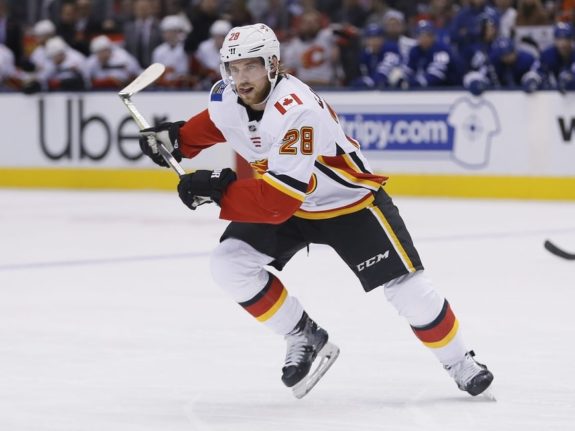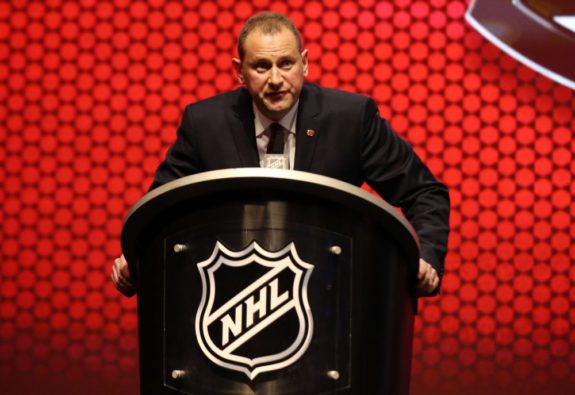Just under a third through the 2018-19 season, the Calgary Flames are one point out of first in the Western Conference with a 19-10-2 record. Early returns suggest this is the best Flames team in many years.
Early this week, they were on top of the West for the first time since Jan. 5, 1993. This achievement is even more impressive when you consider Mike Smith’s struggles in net and the fact that their big-fish free-agent signing, James Neal, has been a major disappointment with just six points.
A lot of teams look unstoppable in December and first-round cannon fodder in April, but sometimes, teams are actually that good. The last two Flames teams with this hot a start demonstrate that.
Calgary has 19 wins in their first 30 games. That’s tied for the second-highest win total through 30 games in team history. They had 19 wins in 2009-10 and 21 wins in 1988-89.
40 points is third-highest through 30. They had 41 in 2009-2010 and 46 in 1988-1989. #Flames
— Pat Steinberg (@Fan960Steinberg) December 9, 2018
In 1989, the Flames won their first and only Stanley Cup, but in 2010, they missed the playoffs in the last gasp of general manager Darryl Sutter. 2009-10 was the first of five straight seasons out of the playoffs for the Flames and the 2018-19 team is the result of the ensuing rebuild.
Nonetheless, being on top this early may produce as much anxiety as elation for Flames fans. Comparing the team to 1989’s would be deeply premature, but it is still clear how this team is different. Putting aside the team’s record, there is more reason to believe this team is for real simply based on their roster construction.
Offensive Depth Unparalleled in Recent History
One of the biggest reasons for their ascent has been the phenomenal success of the Flames’ four 30-point scorers: Johnny Gaudreau, Sean Monahan, Matthew Tkachuk, and Elias Lindholm. The ageless Mark Giordano has also scored 29 points from the blue line. This kind of offensive depth – particularly from players 25 and younger – is something the team simply has never had at any point in recent memory.
Skeptics of this season’s team may point to their puck luck and overreliance on third-period comebacks. The 2014-15 Flames rode those two unsustainable factors to a second-round appearance despite poor possession numbers. But the similarities are merely superficial — this year’s underlying numbers are decidedly less fluky.

This season, some Flames are perhaps shooting a little high (most notably, Lindholm’s 16 goals have come from shooting double his career average of 9.9%), but overall, the team is performing at a sustainable level. Largely because of poor goaltending, the team had an almost dead-even 100.11 5-on-5 PDO as of Dec. 11. The team 5-on-5 shooting percentage is reasonable, leading them to be fourth in the NHL in goals for (107). Finally, and perhaps most importantly, their even-strength possession rate was sixth in the league at 53.66% as of Dec. 11. These numbers are on pace with juggernauts such as the Tampa Bay Lightning, Toronto Maple Leafs, Winnipeg Jets and Nashville Predators.
Treliving vs. Sutter: What a Difference a Decade Makes
The Flames’ elite scoring depth this season shows how Treliving has mastered something Sutter never could. The last time the Flames emerged from a rebuild into high expectations, like they have done so this season, was 2005-06 when they were fresh off being one goal from the Cup in 2003-04.
After 31 games in 2005-06, the Flames also sat strong, with an 18-9-4 record. They won the division but would lose the first of four straight first-round series. In other words, this is not the first time in recent memory the Flames have appeared to be in a contention window.

Even at that time, though, when fan faith in Sutter was at an all-time high, his core of Jarome Iginla, Robyn Regehr, and Miikka Kiprusoff were already older than most of the current core of Monahan, Gaudreau, Tkachuk, and possible core piece Lindholm.
The only older Flames core player is the 36-year-old Giordano. Even when (or if) Giordano eventually declines, the team appears to have a succession plan via genuine blue-chip prospects Rasmus Andersson, Juuso Valimaki, and Oliver Kylington. This, too, demonstrates how much the franchise has changed for the better in 10 years.
Flames’ Cupboard Is Finally Stocked
In their 5-2 win over the Nashville Predators on Dec. 8, the Flames iced three legitimate prospects, all from their 2015 draft class: Andrew Mangiapane, Andersson, and Kylington. The latter got his first career NHL goal after 14 points in 18 AHL games this season:
Unlike Sutter, Treliving has emphasized drafting high-ceiling players over those who have low risk but a low ceiling. Kylington, for instance, was a projected first-rounder who fell to the end of the 2nd round. Mangiapane, who has been blocked by Sam Bennett and others for quite some time, is the classic highly-productive junior forward who falls to the later rounds of the draft due to his size (the 5-foot-10 winger was nabbed in the sixth round.)
Sutter’s main downfall was abysmal drafting — never being able to find cheap, productive, team-controlled young players. It is Treliving’s greatest strength.
The Promise of This Start Is Real
For better or worse, it is hard not to see the 2018-19 Flames as the most promising Calgary team in over a decade. Regardless of how long they stay hot, their depth and long-term outlook are clearly better than at any point in recent memory.
Admittedly, it is not uncommon for teams to be at or near the top of the league in December and then fade. The Los Angeles Kings and St. Louis Blues were the top two Western teams on Dec. 8, 2017; the Kings were swept in round 1, while the Blues missed the playoffs. The same happened to the Montreal Canadiens in 2016-17 — they were the top team in the league in mid-December but lost in the first round.
The biggest question for the Flames is the same one it has been for several seasons: goaltending. The one thing Sutter did that none of his successors have is finding the Flames a true no. 1 goalie — no GM has been able to replace Kiprusoff.
Smith has not shown he can be trusted in a seven-game series; at the same time, the team seems reluctant to give Rittich the no. 1 job, despite his clearly superior statistics.
Nonetheless, what makes this team notable is there are no glaring holes in their roster construction, apart from the net. At the pace they’re on, only bad luck or poor management decisions can stop them. Admittedly, these are big “ifs.”